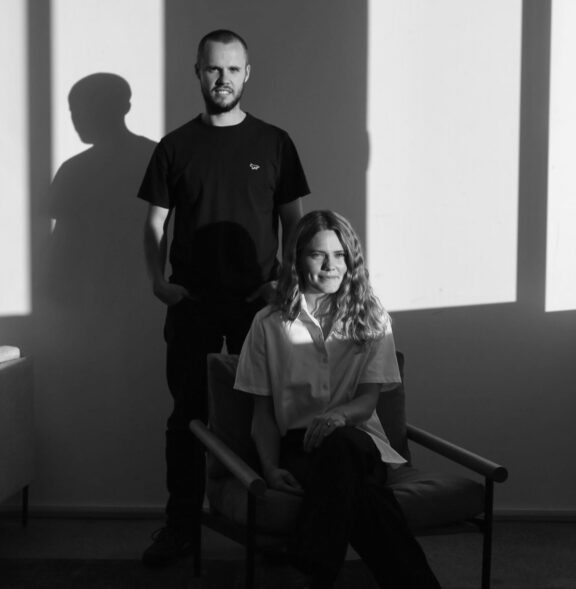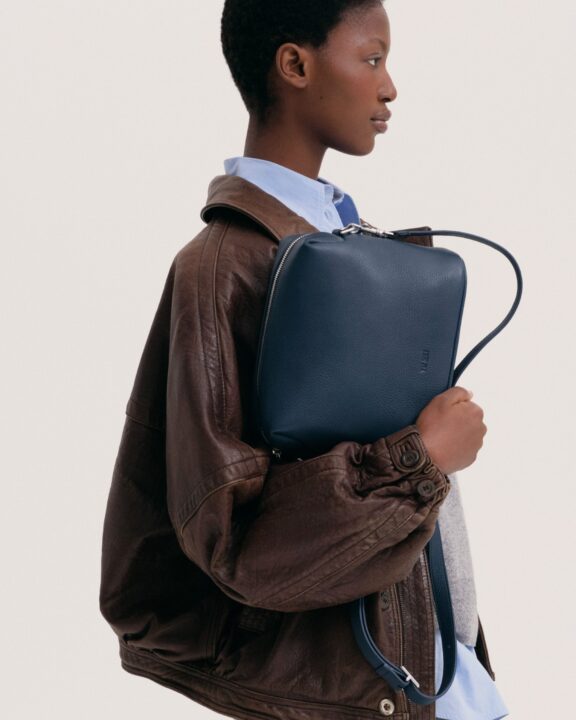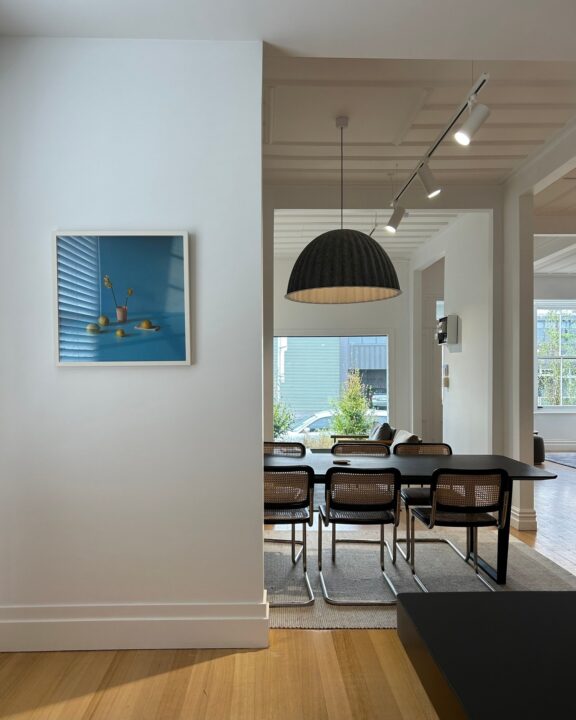In Conversation With: Tom Gibson of PILOT Ash sits down with our Founder Tom to talk about how PILOT came to be, why staying small is a strength, how we’re helping ambitious brands grow in 2025, and the balance of growing a business and family simultaneously.

Meet Tom and Ash, the duo behind Pilot, a boutique digital agency built for creative, design-led brands that care as much about brand integrity as they do performance. What started as a solo venture in 2017 has grown into a purposeful partnership — in life and business. With a considered focus on premium fashion and lifestyle and an intentionally small team, PILOT does things differently. Our approach is hands-on, brand-led, and rooted in deep, long-term collaboration—always prioritising clarity, creativity, and sustainable growth over quick wins.
Kia ora! We're having a long-overdue catch-up across the dining room table while the baby sleeps…Let’s start with the simple stuff— can you tell me about PILOT and why it’s different?
We started out as purely a Facebook advertising agency that served a wide range of industries. However, over time, we realised we were most energised by working with premium fashion and lifestyle businesses — creative, ambitious, and design-led brands. That’s where we’ve chosen to focus, and it’s allowed us to go much deeper rather than trying to serve everyone.
We are intentionally small—both in terms of our team and the number of clients we work with at any given time. This means we’re hands-on with every client and can build really close, collaborative, and more holistic relationships. There’s no middle layer. Either you (Ash) or I are across every strategy, and our core team—all specialists—stays directly involved throughout, providing consistency and the right level of expertise at all times.
It also means we’re not chasing scale just for its sake. We’ve built Pilot in a way that lets us focus our energy and resources on doing great work for the kind of clients we align with. And that’s been key — we’re not trying to be everything to everyone. We know who we’re here for.
I suppose our core point of difference is the brand-led approach. We never let performance come at the expense of the brand. There must always be a harmonious relationship.
"In the world of digital marketing, it’s easy to get caught up in short-term metrics or ROI at all costs. But if the brand suffers, it’s not sustainable. We work with clients who understand that — who want growth, but not at the cost of identity or integrity."
Everything we do — whether it’s paid strategy, digital execution or e-comm — it’s always in service of the bigger picture. It’s about building brands that last, not just ads that convert."


You are the Client Lead for PILOT - how do you choose which clients we work with? How does PILOT cultivate long-term, meaningful partnerships that transcend mere business transactions?
We have a clear vision of the types of clients we want to work with and believe we can achieve great results. After nearly 8 years and over 80 clients, we know our niche. Most importantly, we must be values-aligned and equally ambitious and determined to achieve long-term DTC growth.
The clients we work with typically need to have a unique point of difference in the market, be relatively well established with revenue and/or capital to reinvest in growth, and seek a long-term partnership rather than an agency that can generate quick wins.
We primarily work with clients on recurring monthly retainers that start at least 6 months in duration. As our relationships grow (and we deliver good work), these engagements usually extend for several years, with our average client retention being 3 years.
However, several have been with us from the beginning, and we have grown with them as a trusted sounding board for so much more than strictly ‘digital marketing’ – retail store openings, collaborations, new staff, investment rounds, international expansion, recessions, the list goes on. We truly become part of the business.
When we first engage with an e-commerce brand, what’s the first thing you look for in their current strategy? How do you identify the key areas that need the most attention for long-term success?
We first look at how the brand is portrayed in the market through its current digital marketing and see whether this aligns with how it wants to be perceived in order to highlight key strategic opportunities. A key piece of this is examining the content the brand produces across all platforms—we look for innovative and engaging content that is aligned and cohesive across all channels.
Once we have this holistic view, we dive into the analytics and e-commerce side of the business using our internal benchmarks and online tracker to identify additional areas for improvement and missed opportunities. Traffic, sales sources, and demographics are insightful, alongside AOV, Conversion Rate, Returning Customer Rate, Acquisition Cost, Cost of Site Visitor, Margins, Product Performance, etc.
The last piece of the puzzle is the in-platform performance across accounts, whether that is Klaviyo, Meta, Google, TikTok, Pinterest, etc. We look at every aspect, from the account structure to audiences, analytics and tracking, and most importantly, creative. With this, we look to identify wasted money and missed opportunities.
"Budget allocation must be intentional across the channels used and audiences targeted (new/engaged/existing) within those channels. We often find businesses are running blind in terms of budget distribution, particularly with the key platforms, META & Google, pushing the AI-driven campaigns - it is critical to look at where the money is being spent, ensuring investment in generating brand growth and future demand."


Pilot has worked with some of the most dynamic fashion and lifestyle brands across NZ & AU. What do you believe is the key to creating a digital marketing strategy that maintains a sense of exclusivity and luxury while still reaching a broader online audience?
Overall, there needs to be alignment on the ambition of the brand across all parties involved - from creative direction, finance, marketing, product, retail, overall business management and all external parties. Without alignment on the long-term vision, reactionary decisions can be made, which can be highly detrimental, such as going on sale or offering discounts to reach online sales targets. It trains the customer to wait for these, rather than buying at full price.
The key is nurturing brand advocates/existing customers alongside acquiring new ones without being pushy or off-putting. Regarding acquisition, focusing on brand growth through digital marketing rather than ‘pushing products’ always delivers a more luxurious and premium result. Alongside this, I think it’s about reaching a broader audience than you think is your ‘ideal’ customer, and finding pockets of society that are, or can be, prominent advocates of the brand through the content you put out there.
The frequency at which people see the brand is also essential—just regular enough, but not overbearing, so customers don't get put off.
"Tailoring digital marketing across all channels to each audience is essential and really should be a given in 2025. Utilising the data available and previous engagement with a brand to implement segmentation, VIP experiences, customer service, etc., maintains exclusivity and brand loyalty."
How does PILOT strike the balance between data-driven marketing decisions and creative storytelling that resonates deeply with a fashion-forward audience?
We always start with the brand—how it wants to show up in the world, who it speaks to, and how it’s perceived. Without that foundation, any data we use risks being disconnected from the brand and the audience we’re trying to reach.
Product performance data is key for us—what's generating engagement across channels or with KOLs, what’s selling, what isn’t, and what people are returning for. This insight doesn’t just inform buying and merchandising decisions—it directly shapes the marketing creative we use. This is a really great example of the balance between data, product & creative. If certain pieces resonate, we’ll elevate them through tailored edits, targeted ads/EDMS, or product-led storytelling.
"So while data guides us, it never leads without the broader context. For a brand-led audience, creative that feels culturally and emotionally on point is just as important as conversion — the growth in reach and sales comes when they are both in sync."
The majority of our clients are now NZ or AU-based with a focus on global expansion, particularly in the US, UK and EU. What considerations do you think are crucial for brands looking to expand their e-commerce presence internationally?
As more brands focus on international markets, particularly, clarity and consistency become critical. The first step is revisiting product–market fit. What resonates in Australia or New Zealand won’t always translate offshore. Each region brings its own cultural and commercial nuances, and understanding these differences is what separates meaningful market entry from surface-level testing.
Operationally, logistics and customer experience must be seamless. Consumers in these markets expect fast (often free) shipping, easy returns, and localised support. If fulfilment isn’t optimised, retention will suffer. Margins must also be resilient—able to absorb rising CAC, distribution costs, tariff changes, and ongoing brand investment.
"Most importantly, global expansion requires a long-term mindset. It’s no longer quick or inexpensive. Success comes from building brand equity over time, showing up with elevated, locally relevant creative and in-person activations that feel native, and maintaining a considered approach to testing, iterating, and scaling intentionally in each new market."
What is one piece of advice you would give NZ brands looking to expand into the AU market?
Be prepared to adjust your product and your creative.
As the retail landscape continues to evolve, what future trends are you most excited about for fashion & lifestyle brands in 2025?
In 2025, I’m most excited by the redevelopment of the omnichannel experience. Online and digital have been huge for the last five years (for obvious reasons). However, with in-store shopping returning to pre-pandemic levels and continuous economic turmoil, the in-store experience and in-person events will become more vital. I'm also excited about how online and in-store work together, from data sharing to the shared customer journey experience.
Alongside this, I’m excited by the development of new tech and AI that allows businesses to make more informed decisions about their buying and merchandising. Making smart buying decisions becomes even more crucial as margins get squeezed from every angle.
Finally, new customer acquisition. The older market of 50+ is becoming larger and larger, especially for premium/luxury brands. It will be interesting to see how brands begin to market to this potential customer without making the brand ‘old’ or ‘not cool’. It's not really a trend, but I’m fascinated to see it!
For those that don’t know, you & I had our first child, Maggie, last year. She is the light of our life and has provided a profound sense of clarity on what is important both in business and for our growing family. The two roles - being a parent & managing a digital agency are inherently intertwined.
How have you found the first 11-months juggling becoming a first-time father and managing an agency?
Becoming a Dad has changed everything—in the best way possible. It has been the best thing that has ever happened to me, but also the most daunting. The juggle has been very real, but I think becoming a father has made me a much better business owner and leader. I have a lot more understanding and empathy for others, and in particular, other parents—realising that time is the most precious asset for everyone.
I want to be available and hands-on with Maggie, so I’ve had to become hyper-aware of working on the most important things and in the most effective and productive way possible. Whether that's in the office, at home, in the car, or whenever there is a spare minute, work/home life is more fluid.
Since becoming a Dad, I have also become a lot more reflective. I want to be the best Dad, which inherently means being the best version of myself. It’s forced me to look at different aspects of my life that can be better or more meaningful.
There’s an inherent fluidity between business and personal life when you work closely with a partner. How do you try to separate the two, or do you embrace the blurred boundaries?
A couple of years ago, we tried to draw a hard line between work and home—no work talk after a certain time, no early morning debriefs (which was mostly me). But honestly, it created more tension than it solved. These days, we’ve embraced the blurred boundaries.
One of the upsides of running our own business—and both being involved—is the flexibility that comes with it. The lines aren’t always clear, but that’s part of what makes it work. I can be home when I’m needed, and you can jump in at work when it counts. It’s less about separation and more about working towards a fulfilling life.


Looking ahead, how do you envision Pilot’s growth, both professionally and personally? What are your hopes for balancing your roles as entrepreneur and parent as our family & business continue to evolve?
Pilot’s growth is now far more intentional. It’s no longer about scaling for the sake of it, but about growing with purpose. That shift has sharpened our proposition—to the market, but also internally. It’s made us better at what we do and clearer on who we do it for.
This means doubling down on the work we love, showing up fully for the clients we believe in, and offering true value to our clients. We’re at a stage where we simply don’t have the space to take on anything misaligned, so we will continue working with great people who do amazing things.
"Balance is an interesting term. I don’t think we’ll ever have the perfect balance. However, I hope that our family is happy, healthy, safe, & secure, which will make me the best father and entrepreneur."





